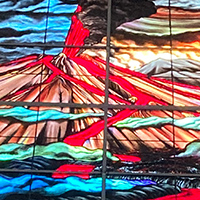 Embracing local holidays in Queensland recently, I found myself in St Monica’s Cathedral in Cairns for the first time in over twenty-five years. I was at last able to behold the magnificent creation windows made in the second half of the 1990s by Gerry Cummins and Jill Stehn. There are twelve windows on each side of the nave, each one measuring 6.5 metres by 1.6 metres. They are a monumental presentation of the Genesis story of the creation of the world, and include many scientific elements in the design together with frequent visual references to the Cairns topography, flora and fauna. They create a dynamic context for liturgy which is both cosmic and local.
Embracing local holidays in Queensland recently, I found myself in St Monica’s Cathedral in Cairns for the first time in over twenty-five years. I was at last able to behold the magnificent creation windows made in the second half of the 1990s by Gerry Cummins and Jill Stehn. There are twelve windows on each side of the nave, each one measuring 6.5 metres by 1.6 metres. They are a monumental presentation of the Genesis story of the creation of the world, and include many scientific elements in the design together with frequent visual references to the Cairns topography, flora and fauna. They create a dynamic context for liturgy which is both cosmic and local.
The story begins at the sanctuary end of the cathedral on the northern side and ends near the sanctuary on the southern side.
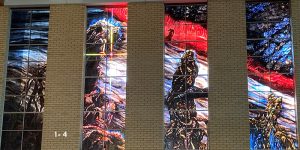
The first windows move from the void, the alien world of darkness, to the coming of light. The cross of light in the second panel is centred on a prism which casts rainbow beams of light when hit by the afternoon sunlight. Imagery from the Hubble Space Telescope is prominent: pillars of dust from the ‘Eagle’ nebula where the stars are born. The red band is the hydrogen ‘Horsehead’ nebula which lead, in the fourth panel, to our own galaxy, the ‘Milky Way’.
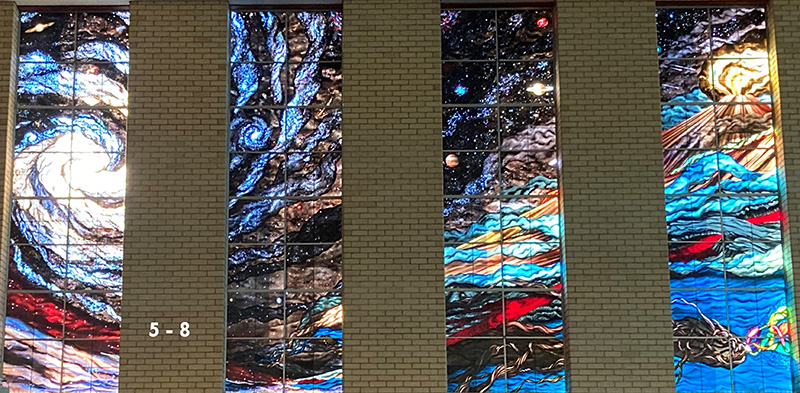
Our galaxy spirals out from the sun in panel five, with the planets shown across panels six and seven (Earth can be seen towards the bottom of panel six). In the great upward sweep of the universe, beginning at the very bottom of panel five and crossing panel six, the boundaries of the earth, sea and sky emerge, culminating in the great conical volcano in panel eight. Clouds and ash swirl as the land mass takes shape. Meanwhile, at the bottom of panels seven and eight, ribbons and ropes entwine like protein chains or umbilical cords until, at the bottom of eight, they come to a brilliant point of light. This refracting prism marks the creation of life. Springing from this point, a colourful helix calls forth a great proliferation of marine life.

Across the top of these final panels on the northern side, a second volcano with streams of red larva appears; turbulent upheaval and lightning storms end at last with clear blue tropical skies. In the process, recognisable landforms appear. The windows offer a kind of profile of the Cairns diocese from south to north: Mt Tyson and Mt Bartle Frere, the Chillagoe lime-bluffs and Mt Mulligan and features of the Atherton Tableland; the Cooktown mountains, Mt Pyke and Lighthouse Rock give way at the end to the tip of Cape York on the horizon. Along the bottom of these panels, the creation of life in panel eight evolves into the shapes of primitive corals and sponges. After horizontal bands of sky and land, this is the sea with a brilliantly depicted Great Barrier Reef. By panel twelve, the reef falls off into a deep chasm where marine life is easily recognisable.
The horizon line continues across the peace windows above and beside the main entrance, and is picked up by the first windows on the southern side of the cathedral.
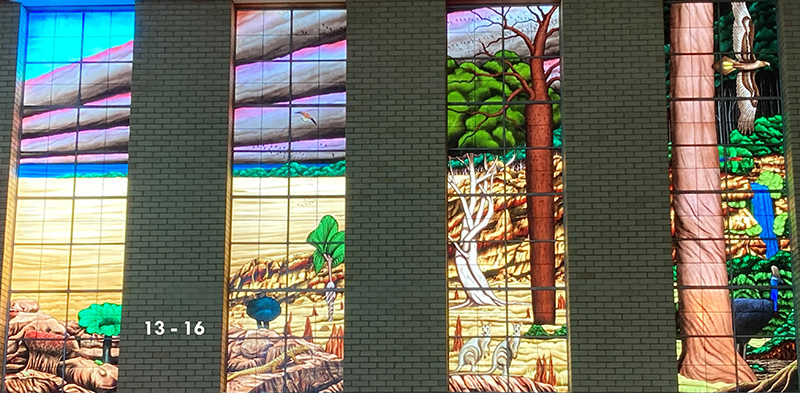
The work of creation unfolds with plants, animals and human beings. This side of the cathedral provides a landscape profile of the Cairns diocese from west to east, beginning with the Normanton grassland and the Gulf of Carpentaria, and moving to the Georgetown area with anthills; cycads and pandanus yield to dry woodland eucalypts and then become abundant rainforest with ferns and waterfalls; finally in panel eighteen, the Cairns coastal plain show heathland and mangroves.
In panel thirteen, fossils of flora and fauna can be seen; reptiles and birds appear in fourteen and intensify in colour and specificity with the appearance of the majestic wedge tail eagle in panel sixteen and the cassowary protectively standing guard over its eggs.
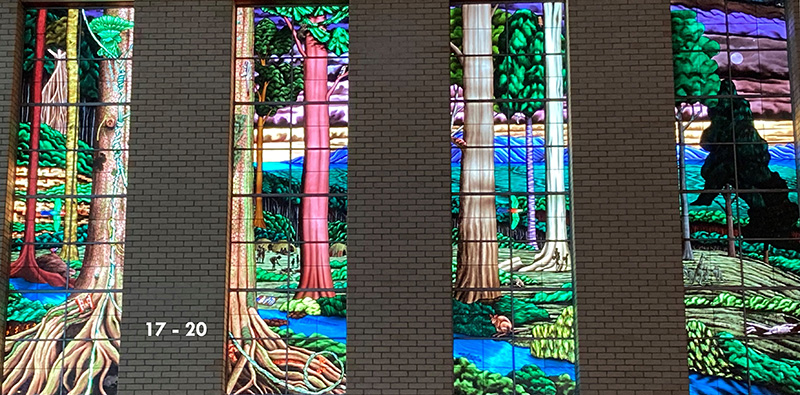
Local animals abound in the beautiful forest by the stream: possum, bettong, pademelon and forest lizard, platypus, kookaburra and koala. They form a great circle across windows seventeen, eighteen and nineteen, surrounding the centrepiece of creation in panel eighteen. Here human beings appear in the garden, depicted as Australian aboriginal people, the crowning glory of God’s creation. The domestic scenes of shelter and mealtime, a barrier to trap fish, vessels and cooking over a fire speak of group harmony and a sense of purpose. But then in panel nineteen, against the background of the Yarrabah Peninsula and the Cairns coastline, some of the humans, armed with spears, are leaving the harmony of the garden. In window twenty, an ominous note is introduced. Evening falls. Crows feast on the carcass of a kangaroo. The discord intimates that the created world is being drawn towards its finality.
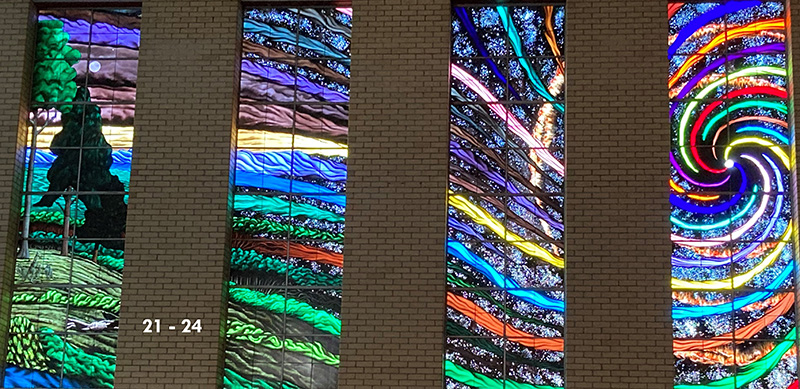
In the final panels the landscape slides away into an exultant and colourful abstract swirl. The spiral centres on a brilliant point of light, another prism set into the window, echoing the creation of light and the swirl of the galaxy on the opposite side of the nave. We have experienced paradise and paradise lost; now we contemplate paradise regained. The apocalypse is not dark, destructive or terrifying. It is a joyous reconnection with God, the centre of our being. It is resurrection after death. All of creation ultimately returns to the Creator of heaven and earth.
This set of twenty-four monumental windows, cosmic in their conception, localised in their portrayal, speak to us of inculturation. Thus it provides a wonderful context for celebrating the liturgy. For what we do in the here and now with the simplest parts of creation – bread and wine, water and oil, and the human touch – are the means by which we participate in the great drama of our salvation by the grace of God.
We know that the whole of creation has been groaning in labour pains until now: and not only the creation, but we ourselves, who have the first fruits of the Spirit, groan inwardly while we wait for adoption, the redemption of our bodies. For in hope we are saved. (Rom 8:22-24).
Tom Elich, Director of Liturgy Brisbane.
I have drawn extensively on the commentary provided by the Diocese of Cairns. Their website provides a written and audio commentary on each panel.
https://cairns.catholic.org.au/about/st-monicas-cathedral/cathedral-windows/creation-windows

